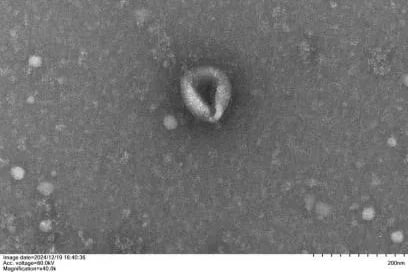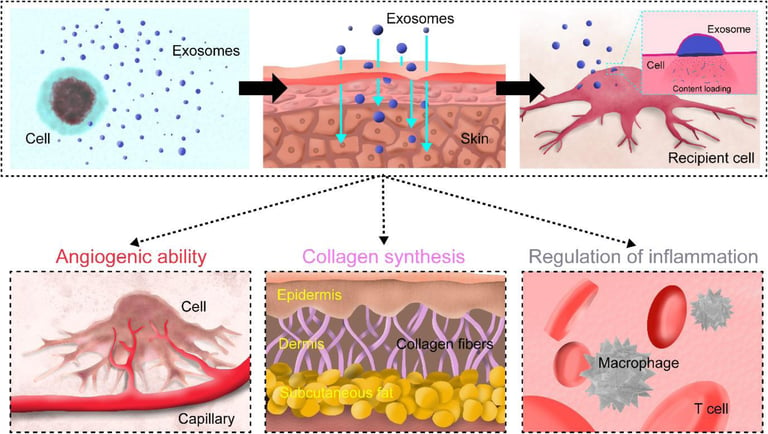Deep Dive into Exosome Therapy for Reducing Wrinkles
A blog post goes deeper on the exosome therapy and its application in reducing wrinkles
3 min read
In the ever-evolving world of aesthetic medicine and skin rejuvenation, a new player is making waves—exosome therapy. With promises of smoother skin, reduced wrinkles, and improved skin texture, this cell-derived technology is gaining attention from dermatologists, spa owners, and beauty professionals alike. Dr. Michelle Henry, a board-certified dermatologist, told Dermatology Times: “Exosome therapy is one of the most exciting developments in regenerative aesthetics. It's not about filling or freezing—it's about repairing and rebuilding skin health from within.” But what exactly are exosomes, and how effective are they in the fight against aging?
What Are Exosomes?
Exosomes are nano-sized extracellular vesicles (30-150 nm in diameter) released by almost all cell types, including stem cells. They carry a powerful cargo—proteins, lipids, and nucleic acids (such as mRNA and microRNA)—that facilitate cell-to-cell communication. Think of them as messengers that deliver instructions to neighboring cells to repair, regenerate, or modulate their behavior.
In skincare and aesthetic treatments, stem cell-derived exosomes, especially those from mesenchymal stem cells (MSCs), are of particular interest because of their regenerative and anti-inflammatory properties.


How Do Exosomes Reduce Wrinkles?
Wrinkles form primarily due to collagen breakdown, skin dehydration, sun damage, and slowed cellular repair. Exosome therapy addresses these issues through:
Collagen and Elastin Production
Exosomes stimulate fibroblasts to produce collagen and elastin—key proteins for skin firmness and elasticity.Reference: Hajialiasgary Najafabadi A., et al. (2024). "Exosomes in skin photoaging: biological functions and therapeutic opportunity" Journal of Cell Commun Signal. 2024 Jan 12;22(1):32.
[PubMed]Anti-Inflammatory Effects
Chronic inflammation contributes to aging. Exosomes reduce inflammatory cytokines, creating a healthier skin environment.Reference: Ha DH, et al. (2020). "Mesenchymal Stem/Stromal Cell-Derived Exosomes for Immunomodulatory Therapeutics and Skin Regeneration" Cells. 2020 May 7;9(5):1157
[PubMed]Improved Skin Barrier and Hydration
They boost skin hydration by enhancing lipid synthesis and restoring the skin barrier, making the skin appear plumper and more youthful.Reference: Park GH, et al. (2023). "Efficacy of combined treatment with human adipose tissue stem cell-derived exosome-containing solution and microneedling for facial skin aging: A 12-week prospective, randomized, split-face study" J Cosmet Dermatol. 2023 Dec;22(12):3418-3426
[PubMed]
Cellular Regeneration
Exosomes promote keratinocyte proliferation and migration, which are essential for skin renewal and wrinkle reduction.Reference: Hade MD, et al. (2021). "Mesenchymal Stem Cell-Derived Exosomes: Applications in Regenerative Medicine"
Cells. 2021 Aug 1;10(8):1959
[PubMed]


Clinical Use and Treatment Protocols
In aesthetic clinics and medispas, exosomes are usually delivered via:
Microneedling + Exosome Serums
Laser Treatments + Exosomes
Topical Application
Treatment Frequency:
A typical course includes 3–4 sessions spaced 2–4 weeks apart, though protocols may vary depending on the skin condition and provider.
Downtime:
Minimal, especially compared to fillers or lasers.
Exosomes are often used with other treatments, rather than as a replacement.
Safety and Regulations
Currently, exosome products are not FDA-approved as stand-alone drugs or biologics for cosmetic use in the U.S., but they are used off-label in many aesthetic practices.
Important Note for Practitioners:
Make sure to source exosomes from reputable companies that comply with Good Manufacturing Practices (GMP) and ensure rigorous testing for sterility and purity.
Final Thoughts
Exosome therapy is not a passing trend—it represents a paradigm shift in how we approach skin aging. With robust scientific backing and visible clinical results, exosomes are positioning themselves as a cornerstone of regenerative skincare. Aestheticians and spa owners are increasingly incorporating exosome-based facials into their premium service menus.
Whether you’re a skincare enthusiast, a spa owner exploring new treatment offerings, or a dermatologist seeking non-invasive rejuvenation options, exosomes deserve your attention.
Disclaimer: The information provided on this website is for educational purposes only and is not intended as medical advice. No exosome product discussed or referenced herein has been approved by the U.S. Food and Drug Administration (FDA). Individuals seeking medical advice or treatment should consult with a qualified healthcare professional.